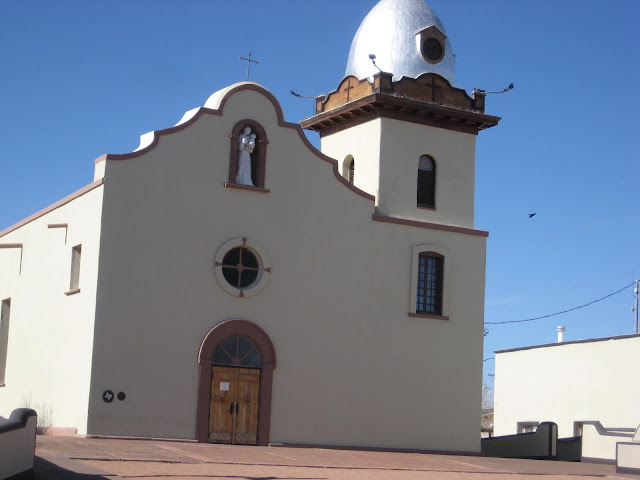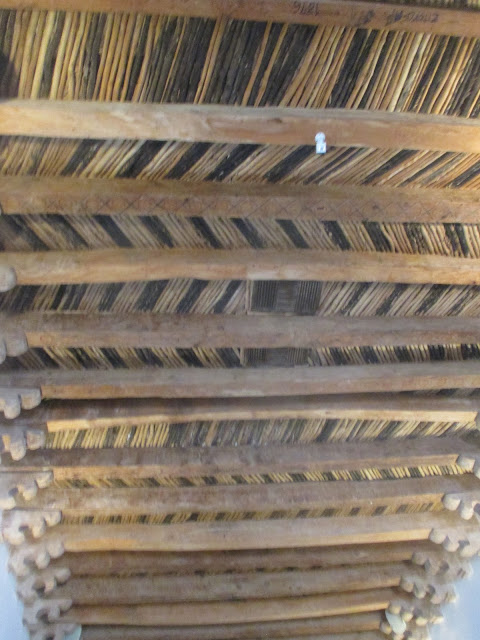January 21-26
Safford was just a quick stop on the way, and that was lucky.
The best-rated place in town, the Plank bar, was closed because so many employees were sick.
We tried the local diner, which was awful. They managed to make a hash that was not only tough (How do you do that?), but also bone dry. Joanna's bacon was flavorless. Enough said.
We left Safford Friday morning, the 21st, and plowed through more flat, arid country surrounded by razorback mountain ridges to get to the Holiday Inn Express at Deming, New Mexico. It’s a surprising tiny town, well worth a couple of days.
The tourist information center is a converted rail station. Somewhere near there in 1881, the Southern Pacific Railroad and the Atchison, Topeka, and Santa Fe met to complete the second Transcontinental Railroad.
The ceremony of the meeting included driving a silver spike.
We were excited to be reminded that this is the town where on a previous stay we stumbled onto Forghedaboudit, a bona fide Jersey-style Italian restaurant. Apparently our latest information was badly outdated, because when we got to the door we found that the space was for lease.
We went back to a steak house that we had just passed, and that was OK. They served me a prime rib instead of the sirloin that I ordered. It’s a fattier cut. This one was very thin, but they managed to keep it red in the center.
One of our main reasons for coming to Deming on this trip is that it lies about 30 miles north of Columbus, New Mexico, the tiny border town where Pancho Villa for some reason decided to invade the United States in 1916. At the time, the town was home to a few hundred civilians and to a garrison of U.S. Cavalry.
We drove south to Pancho Villa State Park on Saturday.
From what I gathered at the park’s museum and from articles online, Villa was leading a rebel army of about 1,500 men in Chihuahua. He was still in opposition to Venustiano Carranza, whose government had been recognized by several countries, including the United States, as the official government of Mexico.
Loyalties and recognitions shifted several times in the early teens. By 1916 Villa was on the outs with the Americans and had murdered more than a dozen Americans he had kidnapped in Mexico.
In March, he decided to take the fight across the border. At least, this is the usual scenario. There are also arguments that there is no evidence the Villa was with the wing of his army that attacked Columbus.
The attack came as a surprise, and the Villistas managed to burn several buildings and shoot a number of civilians. But the garrison responded almost immediately.
The fight lasted a few hours. Nine civilians and eight U.S. soldiers died. Villa’s forces lost 90 men killed. Their bodies were piled up and burned with kerosene.
Fewer than a dozen of Villa’s followers were captured and later tried as bandits. Most of them were hanged.
The U.S. government authorized a punitive expedition under Black Jack Pershing to enter Mexico and capture Villa.
The museum at the park contains a number of period artifacts, including examples of the early tanks, aircraft, trucks, and staff cars used by the American Army when it invaded Mexico. According to a film shown at the museum, Pershing’s command was the first mechanized force that the U.S. had put into the field.
A striking relic of the battle is a family touring car full of bullet holes. The owner was wounded by fire from the Villistas, but managed to get his family clear of danger.
We had dinner at a local haunt, the Lazy Lizard, where everybody knows each others’ names. It’s a small room inside the local Quality Inn.
Sunday we drove around town. We went as far out as a winery called Lescombes, According to the company’s website, the founder, Herve Lescombes, also founded Domaine de Perignon in Burgundy.
He was drawn to New Mexico because its climate is similar to that of Algeria, where he was born.
I bought a blend of half and half Cabernet Sauvignon and Sangiovese. It was very good. Lots of flavor
During our wandering of the day, Joanna noticed Marie’s Italian Grill, on the corner of Pine and Silver. We went back there later and got an idea of why Forghedaboudit may not have made it in Deming. I mean, how many places like that can a small town in the desert support?
I had a veal parm that was easily the best ever. It was a cut about a quarter-inch thick.
The Ford needed an oil change, so we went to Walmart after we checked out of the Holiday Inn on Sunday morning.
Next stop was Comfort Suites in El Paso, chosen mainly because of its location.
El Paso is a short run from Deming, about two hours and change. But there isn’t much after that for several hours.
We had been to El Paso on our last road trip out here and considered it a been-there, done-that.
I put us in a place near the airport. I’d like to claim it was all carefully researched and planned, but no, it was dumb luck.
We could make a couple of turns out of the parking lot to reach Airway Boulevard, a commercial strip full of places to eat, many of them apparently local.
I had seen a billboard for the West Texas Chophouse and looked that up online. It was easy to find on that strip and very good.
I was originally expecting to get the sirloin that got mixed up in Deming. Then I walked past the guy eating the half-pound hamburger and thought of the Vortex in Atlanta. (You may remember: the “no minors, no whiners” bar in Midtown. “This is the food your mother warned you about. That’s because what is bad is good.”)
I wound up ordering a burger that had a mild green chile and some kind of aioli mayo on it. Fantastic fun. Great with a cab.
Next day, Tuesday, we found we were only a few miles from the local Old Mission Trail. we visited two of them, Ysleta and Socorro.
Both were founded by refugees fleeing the Pueblo Revolt, a vast war by the native peoples of what is now New Mexico, who drove out the Spanish colonists and their native sympathizers in 1680.
Franciscans led a group of Tigua people to Ysleta. Others led Piro followers to Socorro.
Both groups built churches on the Rio Grande flood plain. The adobe buildings dissolved in floods a few years after they were built.
The Ysleta church, dedicated to St. Anthony, is a replica, but besides the loss during the early floods, it suffered almost complete loss after a fire in the early 20th century.
The Tigua operate a casino called Speaking Rock next to the church.
According to a docent in the Socorro church, down the Camino Real, the current structure is almost identical to the one that it replaces. At least, the nave is the same size. The roof beams are the same ones used in the first church. They survived the flood and were reused in the new building.
The Socorro mission church is dedicated to Our Lady of the Immaculate Conception. (Protestants take note: The Immaculate Conception is the conception of Mary without Original Sin, not the virgin conception of Jesus, which took place at the Annunciation.)
As we were talking with the docent, we mentioned that we had visited Quartzsite and found it fun. The docent said that, whenever she drives to California, she stops at Quartzite to fill the tank. It helps her save a few bucks before she crosses the state line and gasoline gets really steep.
Another visitor said he is a fan of Quartzsite and goes there often. He look for gold dust there. He said a lot of people go there for that reason.
You won’t make a living at it but it’s fun, he said. He has found almost two ounces so far. But he’s been at it for 10 years or more.
The photo of the day is a shrine on the grounds of the Socorro mission church.
We had dinner at Johnny Carino’s. It’s right next to the West Texas Chophouse, but it’s tricky to get to.
The chicken cacciatore was all right, but I’ve had better. The sauce was rich enough, but the chicken was boneless and clearly added late.
It took us three hours to reach Pecos, Texas, on the 26th. We’re in another Comfort Suites right by Interstate 20, which we may follow all the way to Georgia. Weather and timing will decide that.
In the meantime, stay well, everyone.
Love to all.
Harry and Joanna











No comments:
Post a Comment